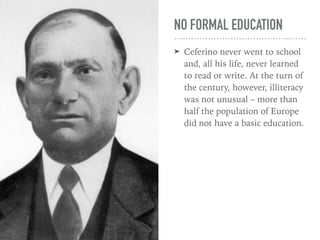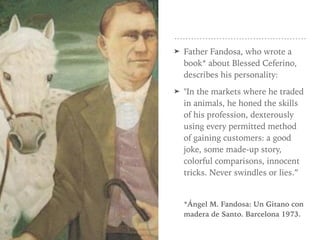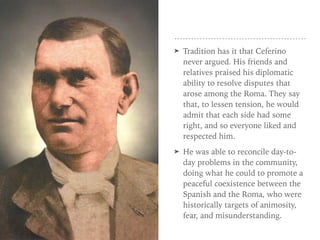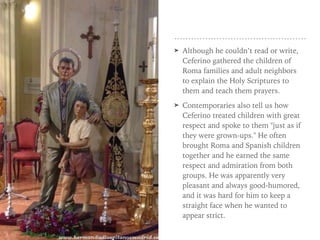Blessed Ceferino Giménez Malla
- 1. BL. CEFERINO GIMÉNEZ MALLA Man of integrity, Good Samaritan, Martyr
- 2. EL PELÉ ➤ Ceferino (or Zefferino) Giménez Malla (1861-1936), known as “El Pelé” (“the strong one” or “the brave one”), was born in Spain of Roma heritage (commonly called “gypsies”; also called Kalòs, Kale, or Gitanos). ➤ He is included among the Vincentian Saints and Blesseds because he was an active member of a conference of the Society of St. Vincent De Paul. https://youtu.be/DL7qu9mhAt8
- 3. EARLY LIFE ➤ He lived as a nomad for forty years and then settled in Barbastro (Spain). He and his family had the typical Gitano expertise with animals, and a passion for bullfighting. Ceferino was proud of his heritage and could speak the gypsy language. https://youtu.be/DL7qu9mhAt8
- 4. NOMADS ➤ Ceferino's family earned their living making baskets. Tradition has it that as a child, Ceferino accompanied his uncle and sold his baskets around the villages. Traveling families such as his usually waited out the winter on farms in places farmers set aside for them, or else they rented a cottage for a few months. https://youtu.be/DL7qu9mhAt8
- 5. LIVING IN POVERTY ➤ Relatives remember Ceferino telling them how he often went hungry as a child: When he returned home from the market and saw the chimney emitting smoke, he was happy because he knew that he would be getting something to eat. When, however, there was no smoke, that meant that the women had not cooked anything. It is very probable that little Ceferino even went begging.
- 6. NO FORMAL EDUCATION ➤ Ceferino never went to school and, all his life, never learned to read or write. At the turn of the century, however, illiteracy was not unusual – more than half the population of Europe did not have a basic education.
- 7. MARRIAGE ➤ According to Roma tradition, Ceferino's father chose his son's bride. Teresa Castro and Ceferino Jiménez Malla were joined in a traditional Roma ceremony. hermandadceferinogimenezmalla.blogspot.com
- 8. ➤ Shortly after his marriage, Ceferino began to trade in donkeys and horses. He quickly became a master of his trade. ➤ To this day, a few of his horseshoeing tools have been preserved. ➤ Ceferino was very successful in the horse markets and had a reputation as an absolutely honest businessman. Holy card, origin unknown
- 9. ➤ Father Fandosa, who wrote a book* about Blessed Ceferino, describes his personality: ➤ "In the markets where he traded in animals, he honed the skills of his profession, dexterously using every permitted method of gaining customers: a good joke, some made-up story, colorful comparisons, innocent tricks. Never swindles or lies.” *Ángel M. Fandosa: Un Gitano con madera de Santo. Barcelona 1973.
- 10. ➤ Fr. Fandosa also tells that once Ceferino allegedly sold an animal to a buyer who did not notice any of its inadequacies. That night, Ceferino thought over what he had done and, in the morning, he hurried to the man to whom he had sold the animal and told him the whole truth. ➤ According to much anecdotal evidence such as this, Ceferino had a spotless reputation around his town.
- 11. ➤ Tradition has it that Ceferino never argued. His friends and relatives praised his diplomatic ability to resolve disputes that arose among the Roma. They say that, to lessen tension, he would admit that each side had some right, and so everyone liked and respected him. ➤ He was able to reconcile day-to- day problems in the community, doing what he could to promote a peaceful coexistence between the Spanish and the Roma, who were historically targets of animosity, fear, and misunderstanding.
- 12. ➤ One of his best friends remembered Ceferino this way: "Very few people understood friendship the way he did." Ceferino treated not only friends, but also strangers, with the utmost respect. Once a few people were playing "guiñote" (card game) in the local bar. His father's group apparently declared Ceferino the winner. However, he reacted with the words: "Here there are neither winners nor losers; here friends are having fun." He never used a sharp word against those with whom he disagreed.
- 13. ➤ Although he couldn’t read or write, Ceferino gathered the children of Roma families and adult neighbors to explain the Holy Scriptures to them and teach them prayers. ➤ Contemporaries also tell us how Ceferino treated children with great respect and spoke to them "just as if they were grown-ups." He often brought Roma and Spanish children together and he earned the same respect and admiration from both groups. He was apparently very pleasant and always good-humored, and it was hard for him to keep a straight face when he wanted to appear strict.
- 14. AN EXAMPLE OF CEFERINO'S WAY OF DOING THINGS ➤ The following story dates back to 1919: ➤ An ex-mayor, Rafael Jordán, suffered from tuberculosis and, on one of his journeys abroad, he had a seizure, with blood flowing from his mouth. They say that Ceferino did not hesitate for a minute. Without fear of contagion, he put the ex-mayor on his back, carried him home and, on the way, gave him words of comfort. ➤ Jordán's brother, Simón, later met with Ceferino to reward him for his help. He offered him a trip to France to buy a wagonload of mules, which Ceferino could then sell for a profit. So Ceferino set out with a sizable sum of money and, when he sold the mules, he hurried back home, not only to return to Simón the money he had borrowed, but also to share his profits with him. Simón Jordán declined his magnanimous offer.
- 15. ➤ Ceferino was able to buy the house which he had been renting until then, and he built a stable. ➤ It is said that he willingly and often lent money to poor Roma, and would also allow them to take any animals they liked most from his stables. They could pay their debts when they sold them or at the end of their seasonal work when they could afford to do so.
- 16. ➤ Ceferino and his wife were childless. After Ceferino's father abandoned his family, his mother died. The couple then took care of Ceferino's younger brothers and sisters, and also Teresa's niece.
- 17. ➤ Many people also remember that Ceferino would accompany a priest on visits to the sick. He attended funerals and christenings at which he and his wife would give generous gifts. He is also said to have often visited the sick at the local poor house and prayed with them. He tried to keep his membership in the St. Vincent de Paul Society a secret; he contributed anonymously. He did not want to humiliate anyone and he always gave alms discreetly: milk to a mother for her child; clothing or food to beggars, etc.
- 18. ➤ At the beginning of the 1920's, Ceferino was thrown into prison by city police after a certain trader accused him of stealing some mules. ➤ Immediately, his close friend, Nicolas Santosa de Otto Escuerda, rushed to his aid. In court, it was proven that someone else had stolen the mules from the market, and Ceferino had bought them without having any idea that the animals were stolen. He even presented the court proof of payment for them. ➤ Eyewitnesses say that, after his return home, they saw Ceferino, two candles in his hands, walking on his knees to the church, a distance of about 700 meters, to thank the Lord. From that time on, he was even more devout and began attending daily Mass. https://youtu.be/DL7qu9mhAt8
- 19. ➤ After the outbreak of the Spanish Civil War, locals recall it was dangerous to move freely in the streets and that day – July 19 – his wife’s niece and family tried to discourage Ceferino from walking to town. His wife’s grand-niece remembers: ➤ "Ceferino was sitting in front of the house and I was sitting next to him. Another Rom was there, too. We were glad that the weather outside had cooled off a bit. All of a sudden, he asked for a cigarette and left.” Ceferino wanted to know what was going on in town. Photo: Donald Press
- 20. ➤ When he saw soldiers arresting a priest, he pleaded for him. The soldiers pounced on Ceferino, beat him with their fists and, when they found a pocket knife and a rosary in his pocket, arrested him, too, and took him away to the local monastery, which had been turned into a prison. He was locked up with 350 other people. ➤ A young anarchist member of the revolutionary committee, Eugenio Sapena, knew Ceferino and visited him. In an attempt to spare him any further suffering, Sapena tried to talk Ceferino into letting him take away his rosary. He said they would then let him go. Ceferino, refused and, according to witnesses, began to pray even harder.
- 21. ➤ Ceferino spent another two weeks in his cell. Early on the morning of August 9, he and nineteen other prisoners were transported to a cemetery in a truck. ➤ The driver later stated that Ceferino, who was about 75 years old at the time, kept proclaiming during the journey, "Long live Jesus the King". Then they placed the prisoners along the cemetery wall and shot them.
- 22. ➤ Forty thousand worshippers attended the celebrations on May 4, 1997, during which Pope Saint John Paul II beatified Ceferino Jiménez Malla.
- 24. Sources: 1. Rombase, a website that offers information on the socio-cultural and socio- historical situation of the Roma, a European nation without its own state, whose members are commonly known by the pejorative denomination of "gypsies". Their mission is to present well-researched material, contributing to the decrease of prejudice and thus help combat stigmatization and discrimination. 2. Homily of Pope John Paul II at the Eucharistic Celebration for the Beatification of Five New Blesseds, May 4, 1997. 3. Pontifical Council for the Pastoral Care of Migrants and Itinerant People presentation by
























